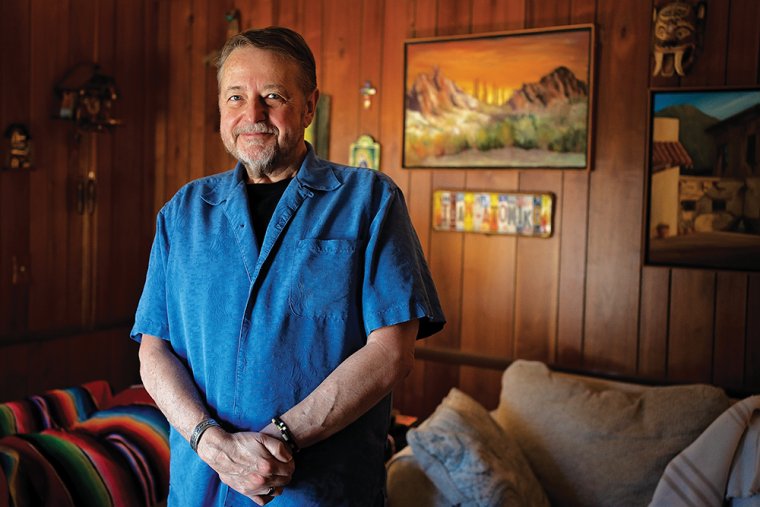The novel Good Night, Irene tells the story of two American women who joined the American Red Cross Clubmobile service during World War II, forged a friendship while seeing and experiencing untold horrors at the front line, and ended up in hugely different circumstances. It’s the kind of novel you’d expect to see from, say, Kristin Hannah—and, in fact, Hannah has blurbed Good Night, Irene, calling it “powerful, uplifting, and deeply personal.”

Luis Alberto Urrea, author of Good Night, Irene. (Credit: Emily Melissa)
But the spring 2023 lead title from Little, Brown, forthcoming at the end of May, wasn’t written by Hannah or another woman. This epic journey told from a female perspective comes to us from none other than Luis Alberto Urrea, the acclaimed author of books about Mexico and Mexican American families, including nonfiction reportage like The Devil’s Highway: A True Story (Little, Brown, 2004) and Across the Wire: Life and Hard Times on the Mexican Border (Anchor, 1993); novels such as Into the Beautiful North (Little, Brown, 2009) and The House of Broken Angels (Little, Brown, 2018); the graphic novel Mr. Mendoza’s Paintbrush (Cinco Puntos, 2010); and poetry collections (his fourth, Piedra, will be released by FlowerSong Press later this year).
Before it’s even possible to ask Urrea about the female perspective from which he has written his new novel, he is explaining the shift in a thoughtful torrent of words. (Urrea confesses he honed his skills as a wordsmith and “big talker” in places like his San Diego high school, where he always had a coterie of girl friends with him. “And I mean girl friends,” he emphasizes. “I was the one they came to for little drawings of sheep on their upper arms, or when we needed to talk our way into a club.”) The point, as he continues, is that Luis Urrea has always been, if not a ladies’ man, a man surrounded by ladies—women, and by “women” he means a family consisting of his grandmother, aunts, and cousins he spent time with whenever his parents sent him to stay with his father’s relatives in the Mexican state of Sinaloa.
Still, not a single major character in Good Night, Irene is a Mexican woman. There is one Mexican American character, a soldier named Garcia, whose role is minor yet meaningful. Much of the action takes place in the European theater or on Staten Island, New York, where his mother grew up in the 1930s. How did Urrea, who has been named to the Latin American Literary Hall of Fame, who was a finalist for a Pulitzer Prize in Nonfiction for The Devil’s Highway: A True Story, who spent years working with and advocating for immigrants at the Mexican border, wind up writing about white women in World War II?
The answer has to do with two specific white women, one of whom is in the new novel, the other living by the author’s side: His mother, Phyllis McLaughlin Urrea, who died in 1990 at the age of seventy-four, and his wife of twenty-seven years, Cinderella “Cindy” Urrea.
![]()
Luis Urrea’s first marriage “imploded” (“the less said about that one, the better,” he says) in the early 1990s. So he decided to leave Boulder, Colorado, where the two had been living, and head to Tucson, Arizona, to research a book that involved the Yaqui, an Indigenous people of Arizona. “I liked the writing community there, too, which included Charles Bowden and Leslie Marmon Silko,” he says. “But one of the first things I got asked to do was to contribute to a serial novel in the Tucson Citizen that they were calling ‘Heat Stroke.’”
The reporter assigning “Heat Stroke” installments was Cindy Somers. “We met for lunch, and she said, ‘No offense, but I don’t know your work.’” Luis tilts his head toward his spouse with long-held affection. Cindy laughs, the sunlight streaming through the windows of their hotel room in Key West, Florida, where Luis is teaching at this year’s Key West Literary Seminars.
Their initial lunch lasted three hours; they now have a grandson (the child of Cindy’s daughter from a previous marriage, Megan) and a daughter of their own, Chayo, a recent graduate of the University of Illinois in Chicago. “It was the second marriage for both of us, and we’re not messing around, you know?” says Cindy. “For Luis to have the kind of career he wanted to have, I needed to quit the newspaper business and help him do the research that became The Devil’s Highway.”
When Cindy Urrea says “help him do the research,” she is not implying she was some sort of invisible amanuensis, akin to the character of Joan Castleman in Meg Wolitzer’s 2003 novel, The Wife, or someone who types feverishly as the Great Man spews deathless prose. Cindy is a strong, opinionated, and accomplished individual who has chosen to collaborate with her spouse on his artistic journey—and, without her, Luis is quick to agree, his new novel wouldn’t exist.
“He’d never told anybody the stories about his mom,” says Cindy. “When he decided to tell me about her service in the Second World War, I said what is wrong with you? Yes, the border, that’s important. But here you have a story about a woman during wartime, right at the front, and you have primary sources, her letters and keepsakes. It’s a personal story that no one else has.”
Phyllis Urrea did have a story: In 1943 she left her family home on Staten Island and joined the Clubmobile service, a little-known arm of the Red Cross that sought to provide a small (and, in many cases, final) taste of home to soldiers at the battle lines in France, Belgium, and Germany. Clubmobiles were glorified food trucks outfitted with coffee urns, doughnut fryers, and usually a trio of young women in canvas uniforms whose mission was to share chat and cheer with “the boys.”
Phyllis and her comrades wanted to go as close to the action as possible, although not all the “donut dollies,” as they were sometimes known, much to their chagrin, shared that ambition. Regardless of their taste for adventure, the women of the Clubmobiles were supposed to be “healthy, physically hardy, sociable, and attractive.” They wore lipstick and nail polish, played swing records and danced with soldiers, and they carried chewing gum, cigarettes, magazines, and sometimes mail on their trucks.
Here was a little-known and even somewhat misunderstood slice of history that Luis Urrea’s mother took part in and that Luis and Cindy Urrea knew had been important to her. And they both knew for certain Luis could bring it to life through fiction. There was just one problem: The mother Luis had known was a nervous, affected woman desperately miserable in her marriage and disappointed by life. How could he write about her as a brave, formidable presence who had moments of deep happiness and connection?
“The skeleton of my mother’s sorrow informs this book,” says Urrea, speaking this time from his Chicago-area home, Cindy again by his side and a vital part of the conversation.








